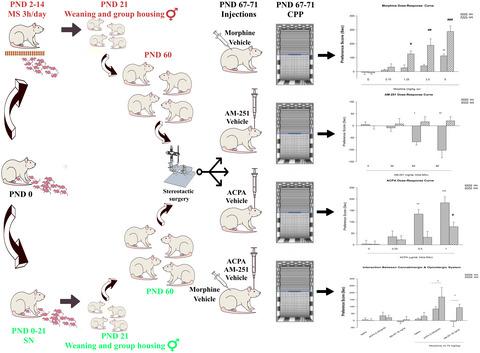当前位置:
X-MOL 学术
›
Int. J. Dev. Neurosci.
›
论文详情
Our official English website, www.x-mol.net, welcomes your
feedback! (Note: you will need to create a separate account there.)
Comparison and interaction of morphine and CB1 agonist conditioned place preference in the rat model of early life stress
International Journal of Developmental Neuroscience ( IF 1.7 ) Pub Date : 2021-02-03 , DOI: 10.1002/jdn.10094 Fardad Pirri 1, 2 , Ardeshir Akbarabadi 2 , Mitra-Sadat Sadat-Shirazi 2 , Setareh Nouri Zadeh-Tehrani 2 , Sarah Mahboubi 2 , Ali Karimi Goudarzi 1 , Mohammad-Reza Zarrindast 2, 3, 4
International Journal of Developmental Neuroscience ( IF 1.7 ) Pub Date : 2021-02-03 , DOI: 10.1002/jdn.10094 Fardad Pirri 1, 2 , Ardeshir Akbarabadi 2 , Mitra-Sadat Sadat-Shirazi 2 , Setareh Nouri Zadeh-Tehrani 2 , Sarah Mahboubi 2 , Ali Karimi Goudarzi 1 , Mohammad-Reza Zarrindast 2, 3, 4
Affiliation

|
Early life stress (ELS) disrupts brain development and subsequently affects physical and psychological health. ELS has been associated with an increased risk of relapse and inadequate treatment response in addicted patients. The current study was designed to find the effect of ELS on the rewarding effect of morphine and cannabinoid and their interaction. Pregnant female Wistar rats were used in this study. On postnatal day 2 (PND2), pups were separated from their mothers for 3 hr daily. This procedure was repeated every day at the same time until PND 14. The control group was kept in the standard nesting way with their mothers. The adult male offspring of maternal separated (MS) and standard nested (SN) rats were used. Using conditioned place preference task (CPP), the rewarding effect of morphine (0.75, 1.25, 2.5, and 5 mg/kg) was evaluated in both MS and SN groups. Besides, the rewarding effect of cannabinoids was investigated using the administration of CB1 receptor agonist (ACPA, 0.25, 0.5, 1 µg/rat) and inverse agonist (AM‐251, 30, 60, and 90 ng/rat) in the nucleus accumbens (NAc). To evaluate the interaction between NAc cannabinoidergic system and morphine, the noneffective dose of ACPA and AM‐251 were administered with a noneffective dose of morphine (0.75 mg/kg) on both MS and SN animals. Obtained results indicated that MS groups had a leftward shift in the rewarding effect of morphine and conditioned with low doses of morphine. However, they had a rightward shift in the rewarding effect of cannabinoids. In addition, coadministration of noneffective doses of morphine and ACPA potentiate conditioning in both MS and SN groups. Previous evidence shows that ELS induced changes in the brain, especially in the reward circuits. Here, we demonstrated that MS animals are more sensitive to the rewarding effect of morphine compared with SN animals. In addition, ELS disrupts the cannabinoid system and affect the rewarding effect of cannabinoids.
中文翻译:

早期生活压力大鼠模型中吗啡和CB1激动剂条件性位置偏好的比较和相互作用
早期生活压力 (ELS) 会扰乱大脑发育,进而影响身心健康。ELS 与成瘾患者的复发风险增加和治疗反应不足有关。目前的研究旨在发现 ELS 对吗啡和大麻素的奖励效应及其相互作用的影响。本研究中使用了怀孕的雌性 Wistar 大鼠。在产后第 2 天 (PND2),幼崽每天与它们的母亲分开 3 小时。这个过程每天在同一时间重复,直到 PND 14。对照组与它们的母亲保持标准的筑巢方式。使用母体分离 (MS) 和标准嵌套 (SN) 大鼠的成年雄性后代。使用条件位置偏好任务 (CPP),吗啡的奖励效果 (0.75, 1.25, 2.5, 和 5 mg/kg) 在 MS 和 SN 组中进行评估。此外,使用 CB1 受体激动剂(ACPA,0.25、0.5、1 µg/大鼠)和反向激动剂(AM-251、30、60 和 90 ng/大鼠)在伏隔核中研究了大麻素的奖赏作用(NAc)。为了评估 NAc 大麻素能系统和吗啡之间的相互作用,对 MS 和 SN 动物给予无效剂量的 ACPA 和 AM-251 和无效剂量的吗啡 (0.75 mg/kg)。获得的结果表明,MS 组在吗啡的奖励作用上有向左移动,并以低剂量吗啡为条件。然而,他们在大麻素的奖励作用上有一个向右的转变。此外,无效剂量的吗啡和 ACPA 的共同给药可增强 MS 和 SN 组的调理作用。先前的证据表明,ELS 会引起大脑的变化,尤其是在奖励回路中。在这里,我们证明与 SN 动物相比,MS 动物对吗啡的奖励作用更敏感。此外,ELS 会破坏大麻素系统并影响大麻素的奖励效果。
更新日期:2021-02-03
中文翻译:

早期生活压力大鼠模型中吗啡和CB1激动剂条件性位置偏好的比较和相互作用
早期生活压力 (ELS) 会扰乱大脑发育,进而影响身心健康。ELS 与成瘾患者的复发风险增加和治疗反应不足有关。目前的研究旨在发现 ELS 对吗啡和大麻素的奖励效应及其相互作用的影响。本研究中使用了怀孕的雌性 Wistar 大鼠。在产后第 2 天 (PND2),幼崽每天与它们的母亲分开 3 小时。这个过程每天在同一时间重复,直到 PND 14。对照组与它们的母亲保持标准的筑巢方式。使用母体分离 (MS) 和标准嵌套 (SN) 大鼠的成年雄性后代。使用条件位置偏好任务 (CPP),吗啡的奖励效果 (0.75, 1.25, 2.5, 和 5 mg/kg) 在 MS 和 SN 组中进行评估。此外,使用 CB1 受体激动剂(ACPA,0.25、0.5、1 µg/大鼠)和反向激动剂(AM-251、30、60 和 90 ng/大鼠)在伏隔核中研究了大麻素的奖赏作用(NAc)。为了评估 NAc 大麻素能系统和吗啡之间的相互作用,对 MS 和 SN 动物给予无效剂量的 ACPA 和 AM-251 和无效剂量的吗啡 (0.75 mg/kg)。获得的结果表明,MS 组在吗啡的奖励作用上有向左移动,并以低剂量吗啡为条件。然而,他们在大麻素的奖励作用上有一个向右的转变。此外,无效剂量的吗啡和 ACPA 的共同给药可增强 MS 和 SN 组的调理作用。先前的证据表明,ELS 会引起大脑的变化,尤其是在奖励回路中。在这里,我们证明与 SN 动物相比,MS 动物对吗啡的奖励作用更敏感。此外,ELS 会破坏大麻素系统并影响大麻素的奖励效果。











































 京公网安备 11010802027423号
京公网安备 11010802027423号